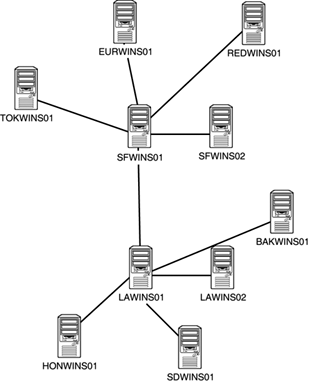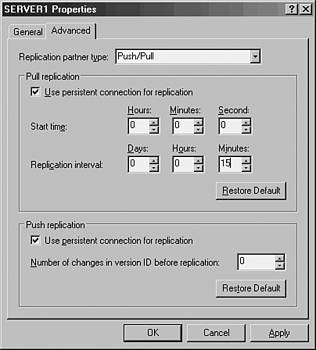Installing and Configuring WINS
| As with many services in Windows Server 2003, the installation and configuration process of a WINS server is streamlined through the Configure Your Server Wizard. This wizard automatically installs all necessary services and databases and configures other settings pertinent to a particular service. Although other methods of installation still exist, this method is the preferred approach in Windows Server 2003. WINS InstallationTo install WINS on a server using the Configure Your Server Wizard, follow these steps:
Configuring Push/Pull PartnersIf a WINS server in an environment is the sole WINS server for that network, no additional configuration is required other than ensuring that clients will be pointing to the WINS server in their IP configuration. However, if additional WINS servers are established in an environment, exchanging database information between the multiple servers will become necessary. You establish this type of replication topology through the designation of push/pull partners. A push partner for a particular WINS server is another WINS server that serves as the destination for WINS changes to be " pushed " to. A pull partner is a WINS server from which changes are "pulled." In a nutshell , if Server1 has Server2 configured as a push partner, Server2 must have Server1 configured as a pull partner, and vice versa. A WINS push/pull topology should roughly map to an organization's network topology. For example, if an organization is composed of two main offices that serve as network hubs, and several branch offices, each with its own WINS servers, the WINS push/pull topology could look something like Figure 13.38. Figure 13.38. Sample WINS push/pull topology. WINS ReplicationWINS replicates database changes on a set schedule, which can be modified on a per connection basis. Just as with any network communications, the replication schedule should be modified to fit the particular needs of an organization. If a WAN link is saturated with traffic, it might be wise to throttle back the WINS replication schedule. However, if a link between push/pull partners is robust, a shorter schedule can be established. To change the default schedule of 30 minutes, follow these steps:
The page shown in Figure 13.39 can also be used to change other push/pull partner settings, such as replication partner types, persistent connections, and other pertinent replication information. NetBIOS Client Resolution and the LMHOSTS FileA Windows client does not immediately resort to a WINS server to determine the IP address of a NetBIOS name. This knowledge is essential in the troubleshooting of name resolution on a Windows client. Instead, a client first contacts a local NetBIOS cache for resolution. If an IP address changes, this cache might report the old address, impeding troubleshooting. To flush this cache, run nbtstat -R (with uppercase R ) at the command line. In addition to the local cache, clients always parse an LMHOSTS file, if one exists, before contacting a WINS server. If the LMHOSTS file contains erroneous information, it will impede proper name resolution. Always check to see whether this file is populated (it is usually located in \%systemroot%\winnt\system32\drivers\etc on clients) before beginning to troubleshoot the WINS server. |
EAN: 2147483647
Pages: 325


